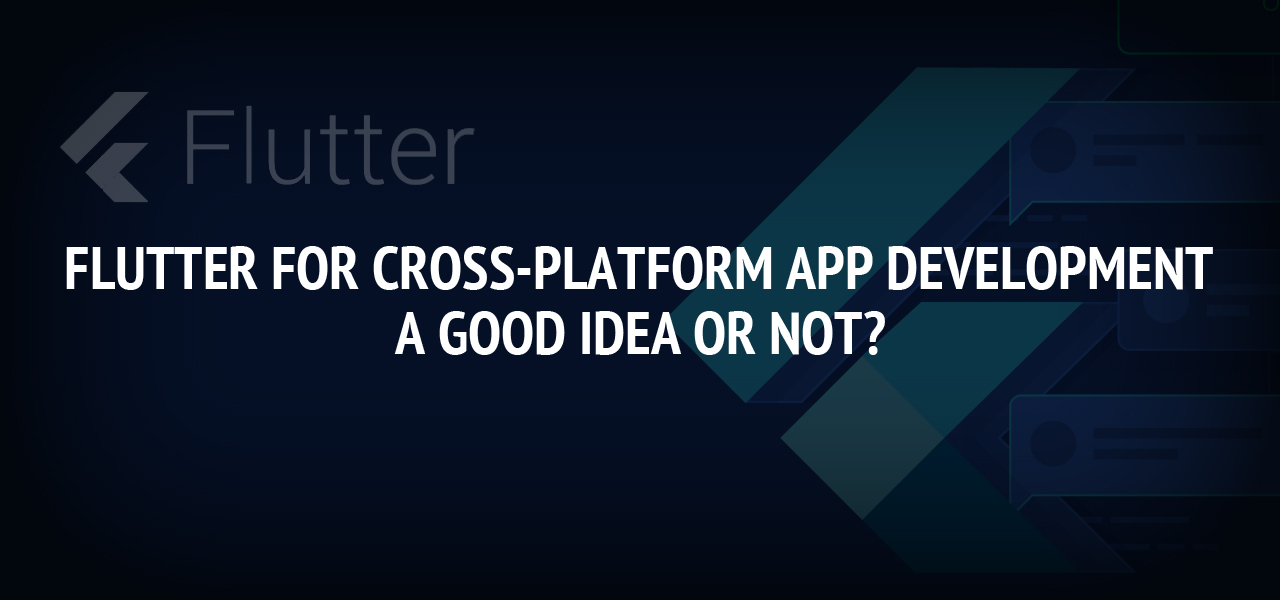Flutter For Cross-Platform App Development: A Good Idea Or Not?

The year after another, the technology evolution that brings staggering promises and opportunities on the top of the table also brings uncertainty in another hand. From the outset, every new technology existence keeps lurking in the dark unless it takes the center stage and scores immense popularity. At the same time, the likelihood of technology to get obsolete soon discourages its adoption. Flutter- the not-so-old kid on the development language block share the resemblance to Topics Base.
A year before, Google announced Flutter 1.0 to build a beautiful user experience in the mobile landscape. The open-source SDK was warmly-embraced to develop front-end in the cross-platform applications. Later, the beta version 1.2 was rolled out to let the developers start building mobile applications using Flutter. Afterward, a steady rise in the Flutter-based apps is seen in the play store.
In the recent Google I/O 2019, Flutter gain enough attention with several improvements, added support for Chrome OS apps development, the new preview version of Flutter for the web, and the Dart 2.3 release with support for UI-as-code features.
In a nutshell, the continuous evolution and upgradation of technology have supercharged Flutter with all the elements that make it a perfect fit for the app development. But, every coin has two faces, you as a developer or entrepreneur must be aware of the advantages and risks that come with Flutter adoption. We have got your needs covered in three sections namely:
- What is Flutter?
- Why it’s a good choice for the cross-platform app development?
- Why developers can stop using technology?
- The road ahead
Let's first begin with what Flutter is:
The SDK is based on Dart programming language, that's jam-packed with all the tools, widgets, documentation, UI blocks, and frameworks that allow the developers to build the cross-platform app using a single codebase. It's considered as best for developing the progressive web app, cross-platform apps with a native feel, and applications communicating to hardware through Bluetooth. Recently, Google has been using Flutter to build a new platform- Fuchsia.
The reasons to consider Flutter:
Performance
Flutter apps gain an extra edge in terms of performance due to its faster and easier connection with native libraries and components through JavaScript Bridge; built-in widgets that alleviate the need to access OEM widgets; Dart, which compiles directly to native code thereby eliminate the need to use JavaScript Bridge to create reactive views. All these factors together result in lesser interaction between the app and the platform and contribute to increased performance.
Besides, C++ powered engine, code reusability, easy set-up, and quick bug fixing lets the Flutter apps render better performance.
Hot reloading
The game-changing feature dramatically speeds up the development process by allowing the flutter developers and designers to perceive the changes to make instantly. Experimenting with new features, giving a few tweaks to the UI, and identifying and fixing the bugs will be no more quite a task because the feature enables the developers to see all the changes that they have made in the source code right in the app in the real-time. The immediate testing of the modifications reveals the app’s look and feel post-changes reflection so that they can be undone, if not enhancing the app’s appeal.
Less coding
With object-oriented Dart language, 100% of the code can be shared across the Android and iOS platform, which means with a single codebase, the app can be created for two platforms. The code reusability leads to less number of lines of code to write. With the hot reloading feature, no extra coding is required when any changes are made to the existing source code.
The UI building blocks
Programmatically, the UI is declared by combining widgets to form a widget tree. Flutter provides a rich set of widgets and additional capabilities to extend or create custom widgets for crafting unique app interface and view. Unlike other frameworks, Flutter won't separate view, controllers, and models, instead, it provides consistent widgets that define button, menu, font, color scheme, padding, and pretty more to create entire screens.
The built-in widgets and ability to create custom widgets give the app a native look and feel. Flutter provides widgets for Google's material design and Apple's style Cupertino that enable crafting a UI which deliver the native experience and delight the users regardless of the screen size and type.
High compatibility
The free to use language is highly compatible with different OS versions because the widgets are not platform-specific. So the developers won't face any compatibility issue on any OS versions. For instance, the Flutter app will work brilliantly on Android Jelly Bean or later versions and iOS 8 or newer versions with no UI or features incompatibility concerns.
Access to native features
There are some functionalities where the use of the native language and access to platform-specific functions is important to render native features in the app. Flutter facilitates the developers to use existing Java, Objective C, and Swift code to access SDKs and native features of iOS and Android for giving the app a feel of development on the native platform.
Note: If you want to create an app with a lot of device-dependent functions, then Flutter cannot be a good choice.
Extended reach to the web
Flutter is no longer mobile only. With the code-compatible implementation of the Flutter using web technologies, the existing Flutter code written in Dart can be embedded in the browser and deployed to the web-server. The Flutter for web enables PWA development which means the businesses can increase the outreach to a broader variety of devices in addition to the web experience. Moreover, pushing dynamic content updates to the mobile apps becomes feasible with existing web view control.
Note: The feature is currently available as a technical preview so it takes time to get the feature rolled out in public in a stable state. It's just what the developers have envisioned the 'Flutter for web' feature.
Rich client base
Presently, the new technology deprives of adoption and recognition, but it's gaining traction in the market with continuous upgrades. Alibaba, Hamilton Musical, Tencent, and JD Finance are some of the leading giants that have leveraged the framework for the mobile app enhancements. The start-ups and Ecommerce players are also trying their hands.
Why developers do not prefer to leverage it for cross-platform development?
Limited continuous integration support
There are a plethora of ready-made solutions for iOS and Android native apps that allow the apps to work with widely supported CI platforms such as Travis and Jenkins, but it's not the case with Flutter. For automatic building, testing, and deployment of the applications, the developers have to create custom scripts and set up the toolkit for these kinds of platforms.
Short of libraries
Flutter's libraries and support are impressive, but not immense, which means there are libraries which help in implementing the functionality in a couple of seconds. But still, the platform is currently in the nascent stage so you won't find enough libraries to readily incorporate any type of functionalities or features. When developers begin to engineer themselves from scratch, it eats up a lot of time.
It's an age of TV apps
After the latest Google announcement, Flutter can be used to develop mobile apps, progressive web apps, and instant app development, but yet no support is provided for Apple TV or Android TV apps. The Flutter apps won't run on smart TVs.
Sum up
There is no middle road between quality and quantity. That's why while developing cross-platform apps, the developers are puzzled to choose which technology stack that can help them deliver a native experience in the budget. Further, avoiding cross-platform road leads to double the investment of efforts, dollars, and time in developing the app for different platforms. Google created a new platform- Flutter to bridge the gap with a prime focus on native performance, elegant UI, and improved productivity.
Besides, the great performance, code reusability, swift testing, stability, high compatibility, and rich set of widgets accelerate the development speed, which makes Flutter perfect for developing cross-platform applications. It's also a good fit to quickly build an MVP when you want to show it to the prospective investors to get the app idea validated.
The shortcomings of the Flutter are far weighed down by its features, advantages, and upcoming improvements. Don't give up the idea of building cross-platform apps using Flutter. Get the ball rolling!
About The Author
Related Blog
View All-
How to Minimize App Clutter and Improve Your Relationship with Your Phone
Our phones have become a part of our daily lives. Not only do we use them for hours upon hours a day, but they are also a tool we cannot part with. They can be highly customized as well, allowing to accomplish so much on the go. Of course, just as you can download ...
-
How Apps are Revolutionizing the Auto Industry
Smartphones have been around since the late 2000s, yet it’s taken car manufacturers over a decade to catch up with all the innovation that these pocket-sized computers have brought into our lives, despite studies showing that smartphones play a major role ...







